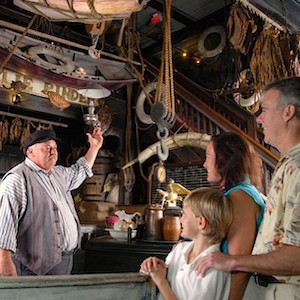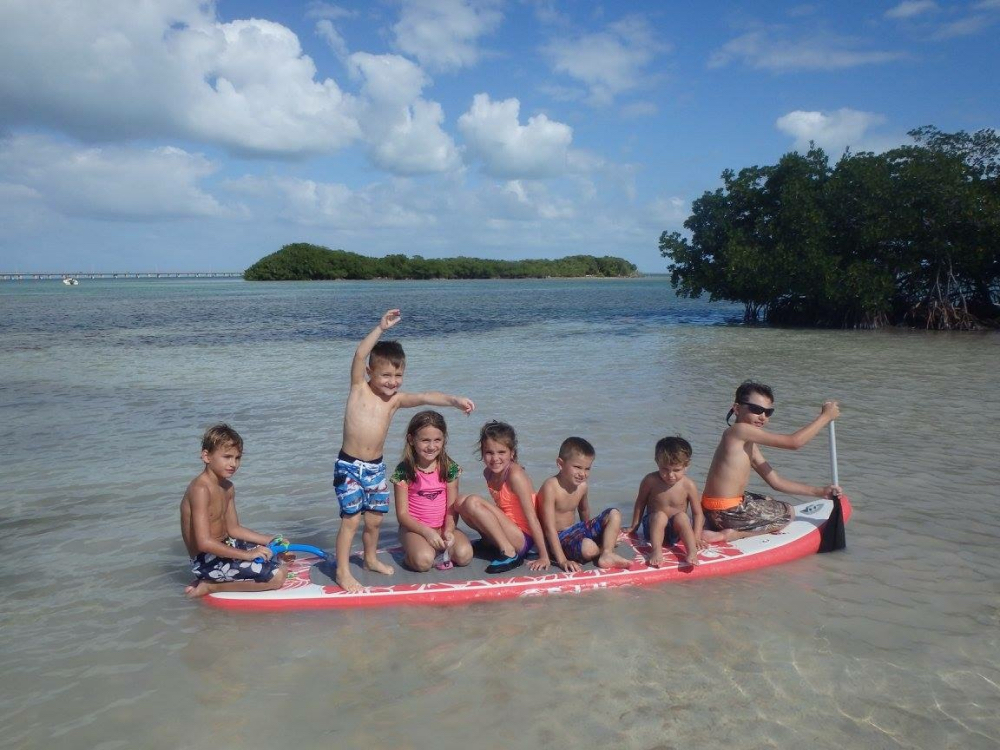From special animal encounters to meeting sea turtles in their very own hospital, the Florida Keys & Key West offer an array of family-friendly activities to captivate the young and young at heart. For example …

A white heron preens at the Florida Keys Wild Bird Center. A self-guided tour along the boardwalks and nature trails allows a close look at resident hawks, ospreys, spoonbills, egrets and more. (Photo by Julie Botteri, Florida Keys News Bureau)
Bird lovers can visit the Laura Quinn Wild Bird Sanctuary run by the Florida Keys Wild Bird Center at MM 93.6 in Tavernier. While the nonprofit conservation center is dedicated to the rehabilitation and release of injured and displaced native wild birds, the sanctuary shelters more than 60 ill, injured or orphaned wild birds that cannot be released — and are all housed in a natural setting.
Islamorada’s lush tropical oasis, Theater of the Sea at MM 84.5, features a variety of fish and marine life, native birds, colorful and personable parrots, sea turtles, crocodiles and exotic plants. Established in 1946, Theater of the Sea is the second oldest mammal facility in the world. Visitors can swim with bottlenose dolphins, stingrays and sea lions; enjoy wild animal exhibits and view parrot, dolphin and sea lion shows at this attraction.
Feeding the tarpon at Robbie’s Marina, MM 77.5 in Islamorada, could be considered the most cost-effective attraction in the Keys. Visitors pay just $2.50 for all-day dock access and $5 for a pail of baitfish to hand-feed the large tarpon, popular gamefish that hang around on an almost year-round basis. Robbie’s also offers paddleboards and kayaks for rent, snorkeling and snuba excursions, eco-tours, private fishing charters (including special “family fishing” experiences) and a party fishing boat for comfortably priced angling off Islamorada — known as the Sport Fishing Capital of the World.
Dolphin Research Center at MM 59 on Grassy Key is an education and research facility where families can see dolphins and sea lions in action in a variety of fun-filled sessions. DRC also offers great interactive programs for all ages, including painting with a dolphin and a family dolphin splash — or even being a trainer for a day. Kids love the water recreation “sprayground” where they can splash through water that shoots from marine and island-themed figures while dolphin, whale, and manatee sounds play.

Feeding the fish isn’t allowed in Florida Keys National Marine Sanctuary waters — but it’s encouraged in Florida Keys Aquarium Encounters’ massive saltwater tank. (Photo by Bob Care, Florida Keys News Bureau)
Feeding the fish is not permitted in the open waters of the Florida Keys National Marine Sanctuary — but at Florida Keys Aquarium Encounters, a unique spot at mile marker 53 in Marathon, families can swim with and feed the fishes while learning about the region’s marine habitats. Visitors can safely feed sharks and other predators through small holes in a thick acrylic barrier. Another highlight is interacting with debarbed stingrays. Additional interactive experiences, such as an immersive coral reef encounter, are available as well.
Opened in 1986 at mile marker 48.5, the Turtle Hospital treats injured sea turtles and, whenever possible, returns them to their ocean home. During daily educational tours, visitors of all ages can “meet” the resident rescued sea turtles and learn about the hospital’s healing programs for loggerhead, green, hawksbill and Kemp’s ridley turtles. The Turtle Hospital was the planet’s first state-licensed veterinary hospital for these fascinating creatures — and even has special “turtle ambulances” to transport patients.
Kids of all ages can try spotting Key deer, an endangered species that lives only in the Lower Keys. These shy, appealing creatures are about the size of a large dog and can be found grazing all around Big Pine Key, especially during early morning hours and around dusk. To learn more about Key deer and other native species, head for the National Key Deer Refuge Visitor Center, located at 30587 Overseas Highway on Big Pine Key (please check the website for hours of operation).

Costumed re-enactors tell the story of the Florida Keys’ salvage or wrecking industry at the Key West Shipwreck Treasure Museum. (Photo courtesy of Historic Tours of America)
Families in the southernmost city should visit the Key West Aquarium at 1 Whitehead St. Opened in the mid-1930s, the aquarium was one of the first family-friendly attractions in the Keys. Today it’s home to grouper, moray eels, barracuda, tropical fish, tarpon, sharks, parrotfish and more. A touch tank featuring small sea creatures is especially interesting to young children. Tours, public presentations and feedings take place throughout the day.
Next door to the aquarium stands the Key West Shipwreck Treasure Museum, where history comes to life with re-creations of the shipwreck salvage and wrecking era through live actors, film and artifacts from the wreck of the Isaac Allerton, which sank off the Keys in 1856. The business of salvaging goods from ships wrecked on Florida Keys reefs made Key West the richest U.S. city per capita in the mid-1800s. Guests can explore the museum while learning about the unique industry, and can even climb the facility’s 65-foot lookout tower.
The Key West Butterfly & Nature Conservatory, 1316 Duval St., is the only butterfly facility in the country that also houses pink flamingos. In the soaring 5,000-square-foot glass-domed tropical butterfly habitat, families can walk among hundreds of living butterflies from 50 to 60 species — and view tiny exotic birds and flamingos Rhett and Scarlett — in a lush rainforest-like setting. Flamingo fans can “flamingle” with Rhett and Scarlett during pre-booked evening encounters.
Want to discover more family-friendly activities in the Florida Keys? No problem — just click here.

